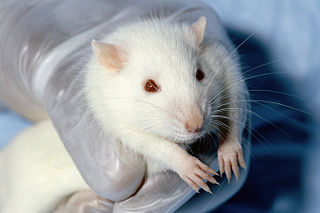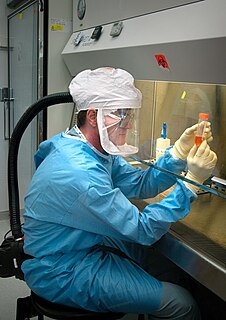This article needs additional citations for verification .(November 2012) |

An individually ventilated cage (IVC) is used to keep an animal separated from other animals and possible exposures, including exposure by air.
This article needs additional citations for verification .(November 2012) |

An individually ventilated cage (IVC) is used to keep an animal separated from other animals and possible exposures, including exposure by air.
In laboratory animal husbandry, there is a huge demand for animals that have been kept in disease free conditions and housed in barrier units such as individually ventilated cages. This is very important because when animals are used for scientific research, particularly drug-related research, the animals must provide accurate and valid results. Using an animal that is ill may cause the severity limit to be exceeded. If the animal already has a disease and then undergoes experimentation of a substance that also produces effects on the animals health, it could potentially worsen the effects of the agent being tested causing the animal to experience more suffering than necessary. The animals may produce false results which may prove vital at a later stage, e.g., in drug trials on humans. Not only that, the experiment will have to be performed again and the previous animals would have ended up being killed. Special caging systems are often used alongside many other barriers to keep unwanted materials out of range of the animals.
The IVC-systems in which the animals are kept in ensures they are fully protected by use of HEPA-filters (high efficiency-particulate air) that defends them from all micro-organisms. A process of sterilisation of all items to be passed in to the barrier unit including bedding material, food etc. must be performed.
The cages are usually made out of high tech special synthetic polycarbonates. Although this material allows various methods of sterilising and disinfecting to be carried out, repeated sterilisation can cause discolouration and brittleness.
The cages are constructed and designed in a specific way to ensure an absolute microparticle free inner environment. This generally includes a cage bottom, a cage top (with a food hopper and water bottle holder incorporated) and a filter lid. It is also designed to allow maximum comfort of the animal and to provide a secure, chew proof environment. An external ventilation unit supplies the cages with fresh HEPA-filtered air which passes through the filter lids. The ventilation-system mostly consists of two tubes for ingoing and outgoing air.
Individual cages, with no environmental enrichment, make it impossible for any animal to carry out species-specific behaviour and are a huge drawback in the terms of animal welfare. In natural conditions, many animals live in groups, but individual cages prevent that. However, that said, multiple sizes of IVCs are available for holding either 1–5 animals or in larger cages 12–15 per cage.

Heating, ventilation, and air conditioning (HVAC) is the use of various technologies to control the temperature, humidity, and purity of the air in an enclosed space. Its goal is to provide thermal comfort and acceptable indoor air quality. HVAC system design is a subdiscipline of mechanical engineering, based on the principles of thermodynamics, fluid mechanics, and heat transfer. "Refrigeration" is sometimes added to the field's abbreviation as HVAC&R or HVACR, or "ventilation" is dropped, as in HACR.

Mouth-to-mouth resuscitation, a form of artificial ventilation, is the act of assisting or stimulating respiration in which a rescuer presses their mouth against that of the victim and blows air into the person's lungs. Artificial respiration takes many forms, but generally entails providing air for a person who is not breathing or is not making sufficient respiratory effort on their own. It is used on a patient with a beating heart or as part of cardiopulmonary resuscitation (CPR) to achieve the internal respiration.

Indoor air quality (IAQ) is the air quality within and around buildings and structures. IAQ is known to affect the health, comfort, and well-being of building occupants. Poor indoor air quality has been linked to sick building syndrome, reduced productivity, and impaired learning in schools. Common pollutants of indoor air include: Secondhand tobacco smoke, air pollutants from indoor combustion, radon, molds and other allergens, carbon monoxide, volatile organic compounds, legionella and other bacteria, asbestos fibers, carbon dioxide, ozone and particulates. Source control, filtration, and the use of ventilation to dilute contaminants are the primary methods for improving indoor air quality in most buildings.

A cleanroom or clean room is an engineered space, which maintains a very low concentration of airborne particulates. It is well isolated, well-controlled from contamination, and actively cleansed. Such rooms are commonly needed for scientific research, and in industrial production for all nanoscale processes, such as semiconductor manufacturing. A cleanroom is designed to keep everything from dust, to airborne organisms, or vaporised particles, away from it, and so from whatever material is being handled inside it.

Radioactive contamination, also called radiological pollution, is the deposition of, or presence of radioactive substances on surfaces or within solids, liquids, or gases, where their presence is unintended or undesirable.

HEPA filter, also known as high-efficiency particulate absorbing filter and high-efficiency particulate arrestance filter, is an efficiency standard of air filters.

An air purifier or air cleaner is a device which removes contaminants from the air in a room to improve indoor air quality. These devices are commonly marketed as being beneficial to allergy sufferers and asthmatics, and at reducing or eliminating second-hand tobacco smoke.
A particulate air filter is a device composed of fibrous, or porous materials which removes solid particulates such as dust, pollen, mold, and bacteria from the air. Filters containing an adsorbent or catalyst such as charcoal (carbon) may also remove odors and gaseous pollutants such as volatile organic compounds or ozone. Air filters are used in applications where air quality is important, notably in building ventilation systems and in engines.

An air handler, or air handling unit, is a device used to regulate and circulate air as part of a heating, ventilating, and air-conditioning (HVAC) system. An air handler is usually a large metal box containing a blower, heating or cooling elements, filter racks or chambers, sound attenuators, and dampers. Air handlers usually connect to a ductwork ventilation system that distributes the conditioned air through the building and returns it to the AHU. Sometimes AHUs discharge (supply) and admit (return) air directly to and from the space served without ductwork

Nuclear War Survival Skills or NWSS, by Cresson Kearny, is a civil defense manual. It contains information gleaned from research performed at Oak Ridge National Laboratory during the Cold War, as well as from Kearny's extensive jungle living and international travels.
Potassium nitrate is an oxidizer so storing it near fire hazards or reducing agents should be avoided to minimise risk in case of a fire.

A filtered air positive pressure environment in laboratory animal science is a space that is under positive pressure with respect to the outside world. In this way, no germs that could affect the lab animals or that are a threat to the SPF status can enter the facility. To bring in new air, high efficiency particulate air filters (HEPA) are used.

Mold or mould, also sometimes referred to as mildew, is a fungal growth that develops on wet materials. Mold is a natural part of the environment and plays an important part in nature by breaking down dead organic matter such as fallen leaves and dead trees; indoors, mold growth should be avoided. Mold reproduce by means of tiny spores. The spores are like seeds, but invisible to the naked eye, that float through the air and deposit on surfaces. When the temperature, moisture, and available nutrient conditions are correct, the spores can form into new mold colonies where they are deposited. There are many types of mold, but all require moisture and a food source for growth.
Aerobiological engineering is the science of designing buildings and systems to control airborne pathogens and allergens in indoor environments. The most-common environments include commercial buildings, residences and hospitals. This field of study is important because controlled indoor climates generally tend to favor the survival and transmission of contagious human pathogens as well as certain kinds of fungi and bacteria.

A biosafety cabinet (BSC)—also called a biological safety cabinet or microbiological safety cabinet—is an enclosed, ventilated laboratory workspace for safely working with materials contaminated with pathogens requiring a defined biosafety level. Several different types of BSC exist, differentiated by the degree of biocontainment they provide. BSCs first became commercially available in 1950.
The safe handling of carcinogens is the handling of cancer causing substances in a safe and responsible manner. Carcinogens are defined as 'a substance or agent that can cause cells to become cancerous by altering their genetic structure so that they multiply continuously and become malignant'. The Australian NOHSC Definitions divides carcinogens into three categories. Category 1 carcinogens are substances known to be carcinogenic to humans. Category 2 carcinogens are substances that should be regarded as if they were carcinogenic to humans. Category 3 carcinogens are defined as substances that have possible carcinogenic effects in humans but about which there is insufficient information to make an assessment. Substances are most often categorised as category 1 carcinogens by epidemiological data and as category 2 or 3 carcinogens through the results of animal testing. Mixtures containing more than 0.1% of a category 1 or 2 carcinogen or more than 1% of a category 3 carcinogen must also be considered carcinogenic and be appropriately labelled. Many carcinogens are used in industry and everyday life, making the safe handling of carcinogens an important consideration.
Engineering controls are strategies designed to protect workers from hazardous conditions by placing a barrier between the worker and the hazard or by removing a hazardous substance through air ventilation. Engineering controls involve a physical change to the workplace itself, rather than relying on workers' behavior or requiring workers to wear protective clothing.
The health and safety hazards of nanomaterials include the potential toxicity of various types of nanomaterials, as well as fire and dust explosion hazards. Because nanotechnology is a recent development, the health and safety effects of exposures to nanomaterials, and what levels of exposure may be acceptable, are subjects of ongoing research. Of the possible hazards, inhalation exposure appears to present the most concern, with animal studies showing pulmonary effects such as inflammation, fibrosis, and carcinogenicity for some nanomaterials. Skin contact and ingestion exposure, and dust explosion hazards, are also a concern.

Engineering controls for nanomaterials are a set of hazard control methods and equipment for workers who interact with nanomaterials. Engineering controls are physical changes to the workplace that isolate workers from hazards, and are considered the most important set of methods for controlling the health and safety hazards of nanomaterials after systems and facilities have been designed.

The Corsi–Rosenthal Box, also called a Corsi–Rosenthal Cube or a Comparetto Cube, is a design for a do-it-yourself air purifier that can be built comparatively inexpensively. It was designed during the COVID-19 pandemic with the goal of reducing the levels of airborne viral particles in indoor settings.